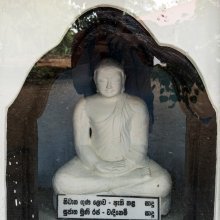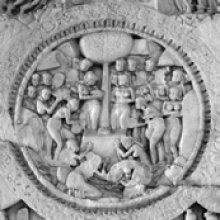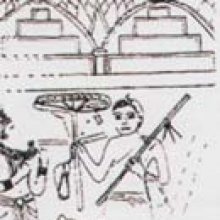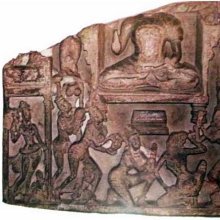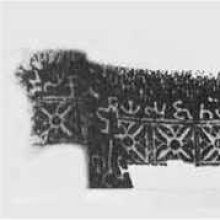Sujata, Sujātā, Sujāta, Su-jata: 21 definitions
Introduction:
Sujata means something in Buddhism, Pali, Hinduism, Sanskrit, Jainism, Prakrit, Marathi, Hindi. If you want to know the exact meaning, history, etymology or English translation of this term then check out the descriptions on this page. Add your comment or reference to a book if you want to contribute to this summary article.
Alternative spellings of this word include Sujat.
Images (photo gallery)
In Hinduism
Purana and Itihasa (epic history)
Source: Wisdom Library: Varāha-purāṇaSujātā (सुजाता) is the name of a beautiful damsel (kanyā), with black curly hair and red lips, according to the Varāhapurāṇa chapter 92. Sujātā (and other innumerable ladies) arose out of the agitation of Vaiṣṇavī while she was doing penance at Viśālā. For these young women, Vaiṣṇavī created the city Devīpura, containing numerous mansions with golden balconies, crystal stairs and water fountains, with jewelled windows and gardens.
Vaiṣṇavī is the form of Trikalā having a red body representing the energy of Viṣṇu. Trikalā is the name of a Goddess born from the combined looks of Brahmā, Viṣṇu and Maheśvara (Śiva).
The Varāhapurāṇa is categorised as a Mahāpurāṇa, and was originally composed of 24,000 metrical verses, possibly originating from before the 10th century. It is composed of two parts and Sūta is the main narrator.
Source: archive.org: Puranic Encyclopedia1) Sujāta (सुजात).—One of the hundred sons of Dhṛtarāṣṭra. He attacked Bhīmasena in the battle of Bhārata and Bhīmasena killed him. (Mahābhārata Śalya Parva, Chapter 26, Verse 5).
2) Sujāta (सुजात).—A monkey King. Sujāta was one of the sons born to Pulaha by his wife Śvetā. (Brahmāṇḍa Purāṇa, 2: 7, 180-181).
3) Sujātā (सुजाता).—The daughter of the hermit Uddālaka. (See under Khagodara).
Source: Cologne Digital Sanskrit Dictionaries: The Purana Index1) Sujāta (सुजात).—A Vānara chief and a son of Śveta.*
- * Brahmāṇḍa-purāṇa III. 7, 181.
2) Sujātā (सुजाता).—A Brahmavādinī.*
- * Brahmāṇḍa-purāṇa II. 33. 19.
Sujāta (सुजात) is a name mentioned in the Mahābhārata (cf. II.48.16, IX.44.61) and represents one of the many proper names used for people and places. Note: The Mahābhārata (mentioning Sujāta) is a Sanskrit epic poem consisting of 100,000 ślokas (metrical verses) and is over 2000 years old.

The Purana (पुराण, purāṇas) refers to Sanskrit literature preserving ancient India’s vast cultural history, including historical legends, religious ceremonies, various arts and sciences. The eighteen mahapuranas total over 400,000 shlokas (metrical couplets) and date to at least several centuries BCE.
Kavya (poetry)
Source: OpenEdition books: Vividhatīrthakalpaḥ (Kāvya)Sujāta (सुजात) is the son of a merchant, as mentioned in the Vividhatīrthakalpa by Jinaprabhasūri (13th century A.D.): an ancient text devoted to various Jaina holy places (tīrthas).—Accordingly, “One day when Priyaṅgu, the wife of Minister Dharmaghoṣa is busy with other women adorning the beautiful Sujāta with jewelry, she is seen of her husband. He tries to get rid of Sujāta by trickery. In vain. Sujāta’s virtue is finally recognized, but, disgusted with the world, he becomes a monk”.
Cf. Āvaśyakacūrṇi II 197.8-200.10; Āvasyakaniryukti (Haribhadra commentary) a.8-a.7; Trad: Balbir in Granoff 1990 p. 56-57.

Kavya (काव्य, kavya) refers to Sanskrit poetry, a popular ancient Indian tradition of literature. There have been many Sanskrit poets over the ages, hailing from ancient India and beyond. This topic includes mahakavya, or ‘epic poetry’ and natya, or ‘dramatic poetry’.
General definition (in Hinduism)
Source: WikiPedia: HinduismSujata (सुजाता): Daughter of Sage Uddalaka and wife of Kagola, his disciple who had virtue and devotion but not much of erudition, mother of Ashtavakra.
In Buddhism
Theravada (major branch of Buddhism)
Source: Pali Kanon: Pali Proper Names1. Sujata. The twelfth of the twenty four Buddhas.
He was born in the city of Sumangala, his father being the khattiya Uggata and his mother Pabhavati. He was called Sujata because his birth brought happiness to all beings. He lived as a householder for nine thousand years in three palaces - Siri, Upasiri and Nanda his wife being Sirinanda and his son Upasena. He left home on a horse, named Hamsavaha, practised austerities for nine months, and attained Enlightenment under a bamboo (mahavelu) tree, after a meal of milk rice given by the daughter of Sirinandanasetthi of Sirinandans; grass for his seat was given by an Ajivaka named Sunanda. His first sermon was to his younger brother, Sudassana, and the chaplains son, Deva, in the Sumangala Park. He performed the Twin Miracle at the gate of Sudassana Park. The Bodhisatta was a Cakkavatti, and entered the Order under the Buddha. Sujatas chief disciples were Sudassana and Deva (Sudeva) among monks and Naga and Nagasamala among nuns. Narada was his attendant. Sudatta and Citta were his chief lay patrons among men and Subhadda and Paduma among women. His body was fifty cubits high; he lived for ninety thousand years, and died at Silarama in Candavati city, where a thupa, three gavutas in height, was erected in his honour. Bu.xiii.1ff.; BuA.168 ff.; J.i.38; Mhv.i.8, etc.2. Sujata. Cousin of Padumuttara Buddha and brother of Devala. He later became one of Padumuttaras Chief Disciples (Bu.xi.24; BuA.159; DA.ii.489). Herannakani (Upaddhadussadayaka) Thera, in a previous birth, gave him a piece of cloth for a robe (ThagA.i.266; Ap.ii.435), while Khema gave him three meal cakes and cut off her hair as an offering to him (ThigA.127; AA.i.187). Dhammadinna also did obeisance to him and offered him alms (ThigA.196; MA.i.516).
3. Sujata. An Ajivaka, who gave grass for his seat to Piyadassi Buddha. BuA.172.
4. Sujata. A king, father of Narivahana (q.v.).
5. Sujata. A king, who later became a hermit. He was the Bodhisatta in the time of Tissa Buddha. Bu.xviii.9f.; J.i.40.
6. Sujata. A yavapalaka, who gave grass for his seat to Vipassi Buddha. BuA.195.
7. Sujata. A king of fifty seven kappas ago; a former birth of Ramsisannaka Thera. Ap.i.210.
8. Sujata. The name of Upali Thera (q.v.) in the time of Padumuttara Buddha. ThagA.i.229.
9. Sujata Thera. He was a brahmin of Benares, father of Sundari Theri. While grieving for the death of his son, he met Vasitthi Theri, and from her he heard about the Buddha, whom he visited at Mithila.
He entered the Order under the Buddha, attaining arahantship on the third day (ThigA.229).
-- or --
1. Sujata. An aggasavika of Sobhita Buddha. J.i.35; Bu.vii.22.
2. Sujata. An aggasavika of Piyadassi Buddha.
J.i.39; Bu.xiv. Theravāda is a major branch of Buddhism having the the Pali canon (tipitaka) as their canonical literature, which includes the vinaya-pitaka (monastic rules), the sutta-pitaka (Buddhist sermons) and the abhidhamma-pitaka (philosophy and psychology).
Tibetan Buddhism (Vajrayana or tantric Buddhism)
Source: Wisdom Library: Tibetan Buddhism1) Sujāta (सुजात) is the name of a Tathāgata (Buddha) mentioned as attending the teachings in the 6th century Mañjuśrīmūlakalpa: one of the largest Kriyā Tantras devoted to Mañjuśrī (the Bodhisattva of wisdom) representing an encyclopedia of knowledge primarily concerned with ritualistic elements in Buddhism. The teachings in this text originate from Mañjuśrī and were taught to and by Buddha Śākyamuni in the presence of a large audience (including Sujāta).
2) Sujātā (सुजाता) also refers to one of the female Śrāvakas mentioned as attending the teachings in the 6th century Mañjuśrīmūlakalpa.

Tibetan Buddhism includes schools such as Nyingma, Kadampa, Kagyu and Gelug. Their primary canon of literature is divided in two broad categories: The Kangyur, which consists of Buddha’s words, and the Tengyur, which includes commentaries from various sources. Esotericism and tantra techniques (vajrayāna) are collected indepently.
General definition (in Buddhism)
Source: Wisdom Library: Buddhism1) Sujāta (सुजात) is the surname of Ikṣvāku (Okkāka): an ancient king from the Solar dynasty (sūryavaṃśa) and a descendant of Mahāsaṃmata, according to the Mahāvastu chapter II.32 of the Mahāsaṃghikas (and the Lokottaravāda school). Sujāta had five sons: Opura, Nipura, Karakaṇḍaka, Ulkāmukha, and Hastikaśīrṣa, and he had five daughters: Suddhā, Vimalā, Vijitā, Jalā, Jalī. Sujāta had another son, named Jenta.
2) Sujāta (सुजात) is the son of Ambaraṃsī: another king from the Solar dynasty (sūryavaṃśa), according to the Mahābuddhavaṃsa or Maha Buddhavamsa (the great chronicle of Buddhas) Anudīpanī chapter 1, compiled by Ven. Mingun Sayadaw. Cittaraṃsī’s son was King Ambaraṃsī. Ambaraṃsī’s son was King Sujātā. Sujātā’s son was King Okkāka.
In Jainism
General definition (in Jainism)
Source: archive.org: TrisastisalakapurusacaritraSujātā (सुजाता) refers to one of the 32 mountains between the lotus-lakes situated near the four Añjana mountains, which are situated in the “middle world” (madhyaloka), according to chapter 2.3 [ajitanātha-caritra] of Hemacandra’s 11th century Triṣaṣṭiśalākāpuruṣacaritra: an ancient Sanskrit epic poem narrating the history and legends of sixty-three illustrious persons in Jainism.
Accordingly:—“In the four directions from each of the Añjana Mountains there are lotus-lakes, 100,000 yojanas square: [...]. Between each two lotus-lakes there are 2 Ratikara Mountains so there are 32 Ratikara Mountains (e.g., Sujātā). On the Dadhimukha Mountains and on the Ratikara Mountains, there are eternal shrines of the Arhats, just as on the Añjana Mountains likewise at the intermediate points of the continent there are 4 Ratikara Mountains, having a length and width of 10,000 yojanas, and a height of 1,000 yojanas, made of all kinds of jewels, divine, the shape of a jhallarī. [...] In them (i.e., the 32 Ratikara Mountains, e.g., Sujātā) the gods with all their splendor together with their retinues make eight-day festivals in the shrines on the holy days of the holy Arhats”.

Jainism is an Indian religion of Dharma whose doctrine revolves around harmlessness (ahimsa) towards every living being. The two major branches (Digambara and Svetambara) of Jainism stimulate self-control (or, shramana, ‘self-reliance’) and spiritual development through a path of peace for the soul to progess to the ultimate goal.
Languages of India and abroad
Pali-English dictionary
Source: BuddhaSasana: Concise Pali-English Dictionarysujāta : (pp.) well born; of good birth.

Pali is the language of the Tipiṭaka, which is the sacred canon of Theravāda Buddhism and contains much of the Buddha’s speech. Closeley related to Sanskrit, both languages are used interchangeably between religions.
Marathi-English dictionary
Source: DDSA: The Molesworth Marathi and English Dictionarysujaṭa (सुजट).—a sometimes sujakaṭa a (sujaṇēṃ) Slightly swollen or puffed.
Source: DDSA: The Aryabhusan school dictionary, Marathi-Englishsujaṭa (सुजट).—a Slightly swollen.
Marathi is an Indo-European language having over 70 million native speakers people in (predominantly) Maharashtra India. Marathi, like many other Indo-Aryan languages, evolved from early forms of Prakrit, which itself is a subset of Sanskrit, one of the most ancient languages of the world.
Sanskrit dictionary
Source: DDSA: The practical Sanskrit-English dictionarySujāta (सुजात).—a.
1) well-grown, tall.
2) well made or produced.
3) of high birth.
4) beautiful, lovely; सुजातं कल्याणी भवतु कृत- कृत्यः स च युवा (sujātaṃ kalyāṇī bhavatu kṛta- kṛtyaḥ sa ca yuvā) Mālatīmādhava (Bombay) 1.16; R.3.8.
5) very delicate; खिद्यत् सुजाताङ्घ्रितलामुन्निन्ये प्रेयसीं प्रियः (khidyat sujātāṅghritalāmunninye preyasīṃ priyaḥ) Bhāgavata 1.3.31.
Sujāta is a Sanskrit compound consisting of the terms su and jāta (जात).
Source: Cologne Digital Sanskrit Dictionaries: Edgerton Buddhist Hybrid Sanskrit DictionarySujāta (सुजात).—(1) in Mahāvastu i.188.3 (verse) seems to be an epithet of the Buddha (compare Pali Sn 548 where it is one of a series of such): (śaraṇaṃ vādi-śārdūlaṃ, i.e. to the B., śreṣṭhī tatra upāgataḥ,) Sujāta-darśanatvaṃ ca śreṣṭhī parya- dhigacchasi (aor.), …and the merchant attained the state of beholding the Well-born (or, of having the same views as…; less likely, of having agreeable views, see next; Senart, la connaissance des devoirs d'un bon fils, which seems scarcely possible); (2) name of two former Buddhas in the same list: Mahāvastu iii.231.6 f.; 235.10; (3) name of a king, app. identified with Ikṣvāku, primeval king of Ayodhyā: Śākete (= Ayodhyāyāṃ) mahānagare °to nāma Ikṣvāku- rājā Mahāvastu i.348.10; (4) var. for Suteja, q.v.; (5) name of a son and successor of King Kṛki(n): Divyāvadāna 22.13; 23.4; Avadāna-śataka i.338.8; (6) name of a rich man of Śrāvastī: Divyāvadāna 44.13; perhaps the same as the seventh son of Anāthapiṇḍada, so named Mūla-Sarvāstivāda-Vinaya iii.136.4 ff.; but Tibetan rab sbyin = Sudatta (2), Bailey, JRAS 1950.180; (7) name of one of the oxen of Trapuṣa and Bhallika: Lalitavistara 381.7, 17.
--- OR ---
Sujātā (सुजाता).—(1) (= Pali id., Malalasekara (Dictionary of Pali Proper Names) 6 Sujātā; contrary to Malalasekara (Dictionary of Pali Proper Names), Pali sources, as Jātaka (Pali) i.68.7 ff., Dhammapada (Pali) commentary i.86.1, agree with [Buddhist Hybrid Sanskrit] as to the time when she presented food), name of the daughter of a village chief (named Nandika in Lalitavistara), who presented food to the Bodhisattva when he broke his fast after his long austerities: Lalitavistara 265.6, 11, 19; 267.14 ff.; Mahāvastu ii.131.10; 200.17; 205.3 ff. (she had been the Bodhi- sattva's mother in 500 previous births); 206.19 (colophon, Sujātā-vyākaraṇaṃ samāptaṃ); 263.15 ff.; 300.12; for Divyāvadāna equivalent see Nandā and Nandabalā; (2) name of a nakṣatra(?): eko sujātāye (no v.l.) nakṣatre jātako Mahāvastu iii.303.7 (prose). Otherwise unrecorded; very probably a corruption.
Source: Cologne Digital Sanskrit Dictionaries: Cappeller Sanskrit-English DictionarySujāta (सुजात).—[adjective] well born or made, beautiful, good, noble; [abstract] tatā [feminine]
--- OR ---
Sujāta (सुजात).—[adjective] well born or made, beautiful, good, noble; [abstract] tatā [feminine]
Source: Cologne Digital Sanskrit Dictionaries: Monier-Williams Sanskrit-English Dictionary1) Sujāta (सुजात):—[=su-jāta] [from su > su-cakra] mfn. (or su-) well born or produced or made, of an excellent kind or nature, fine, beautiful, [Ṛg-veda] etc. etc.
2) [v.s. ...] well grown, tall, [Monier-Williams’ Sanskrit-English Dictionary]
3) [v.s. ...] nobly born, noble, [Ṛg-veda; Śāṅkhāyana-gṛhya-sūtra]
4) [v.s. ...] genuine, sincere (as piety), [Bhāgavata-purāṇa]
5) [v.s. ...] really born (id est. not born in vain), [Bhartṛhari] ([varia lectio] sajātaḥ)
6) [v.s. ...] m. Name of a son of Dhṛtarāṣṭra, [Mahābhārata]
7) [v.s. ...] of a son of Bharata, [Viṣṇu-purāṇa]
8) [v.s. ...] of a bull, [Lalita-vistara]
9) [v.s. ...] ([plural]) of a people, [Harivaṃśa]
10) Sujātā (सुजाता):—[=su-jātā] [from su-jāta > su > su-cakra] f. aluminous slate, [cf. Lexicographers, esp. such as amarasiṃha, halāyudha, hemacandra, etc.]
11) [v.s. ...] a kind of plant (= tuvarī), [Monier-Williams’ Sanskrit-English Dictionary]
12) [v.s. ...] Name of various women ([especially] of a daughter of Uddālaka and wife of Kahoḍa), [Mahābhārata; Purāṇa; Lalita-vistara]
13) Sujāta (सुजात):—[=su-jāta] [from su > su-cakra] n. good birth, b° under an auspicious constellation, [Mahābhārata]
Source: DDSA: Paia-sadda-mahannavo; a comprehensive Prakrit Hindi dictionary (S)Sujāta (सुजात) in the Sanskrit language is related to the Prakrit words: Sujāya, Sujāyā.
[Sanskrit to German]
Sanskrit, also spelled संस्कृतम् (saṃskṛtam), is an ancient language of India commonly seen as the grandmother of the Indo-European language family (even English!). Closely allied with Prakrit and Pali, Sanskrit is more exhaustive in both grammar and terms and has the most extensive collection of literature in the world, greatly surpassing its sister-languages Greek and Latin.
Hindi dictionary
Source: DDSA: A practical Hindi-English dictionarySujāta (सुजात) [Also spelled sujat]:—(a) well-born, born in a noble/prosperous family; hence ~[tā] (nf).
...
Kannada-English dictionary
Source: Alar: Kannada-English corpusSujāta (ಸುಜಾತ):—
1) [adjective] of noble birth born to a respectable family.
2) [adjective] (said of flowers) well-blown; completely expanded.
Kannada is a Dravidian language (as opposed to the Indo-European language family) mainly spoken in the southwestern region of India.
See also (Relevant definitions)
Partial matches: Jata, Cu, Shu.
Starts with: Sujata Jataka, Sujata Sutta, Sujatabuddhi, Sujatajata, Sujataka, Sujatanga, Sujatapaksha, Sujatar, Sujatata, Sujatavaktra.
Ends with: Apsujata, Pashujata, Sanatsujata, Ubhayatahsujata.
Full-text (+97): Sujaya, Sujatata, Saujata, Sanatsujata, Opura, Sujatavaktra, Kahoda, Hastikashirsha, Shuddha, Nipura, Sujatar, Ashtavakra, Sanatsujatavedanta, Karakanda, Sirivivada, Sujatanga, Cularathavimanavatthu, Hamsavaha, Silarama, Sojacca.
Relevant text
Search found 59 books and stories containing Sujata, Su-jata, Su-jāta, Su-jātā, Sujātā, Sujāta, Sujaṭa; (plurals include: Sujatas, jatas, jātas, jātās, Sujātās, Sujātas, Sujaṭas). You can also click to the full overview containing English textual excerpts. Below are direct links for the most relevant articles:
Rig Veda (translation and commentary) (by H. H. Wilson)
The Great Chronicle of Buddhas (by Ven. Mingun Sayadaw)
Buddha Chronicle 12: Sujāta Buddhavaṃsa < [Chapter 9 - The chronicle of twenty-four Buddhas]
Part 3 - The Offering of Ghana Milk-Rice by Sujātā < [Chapter 7 - The Attainment of Buddhahood]
Biography (1): Sujātā, Wife of the Householder of Bārāṇasī < [Chapter 45b - Life Stories of Female Lay Disciples]
The Jataka tales [English], Volume 1-6 (by Robert Chalmers)
Jataka 269: Sujāta-jātaka < [Book III - Tika-Nipāta]
Jataka 306: Sujāta-jātaka < [Volume 3]
Jataka 194: Maṇicora-jātaka < [Book II - Dukanipāta]
Brihad Bhagavatamrita (commentary) (by Śrī Śrīmad Bhaktivedānta Nārāyana Gosvāmī Mahārāja)
Verse 2.4.64-65 < [Chapter 4 - Vaikuṇṭha (the spiritual world)]
Sujata < [October – December, 1983]
Music < [July – September, 1980]
The Rain and the Ocean < [October – December, 1984]
Amaravati Art in the Context of Andhra Archaeology (by Sreyashi Ray chowdhuri)
The offering of milk-rice < [Chapter 3 - Amarāvatī and the Formative Stage of the Buddhist Art]
The Conversion of Yaśa and his friends < [Chapter 3 - Amarāvatī and the Formative Stage of the Buddhist Art]
Epigraphs from Amarāvatī (i) Monks and Nuns < [Chapter 4 - Survival of Amarāvatī in the Context of Andhra Art]
